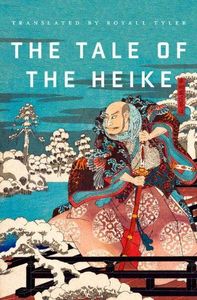Wikipedia:
The Tale of the Heike (???? Heike Monogatari?) is an epic account of the struggle between the Taira and Minamoto clans for control of Japan at the end of the 12th century in the Genpei War (1180-1185). Heike (??) refers to the Taira (?) clan; "hei" being an alternate reading of the kanji (character) for Taira. In terms of the title of the Genpei War, "hei" can be alternatively read as "pei" again and the "gen" (?) is the same kanji used in the Minamoto (also known as Genji) clan's name.
It has been translated into English at least five times, the first by A.L. Sadler in 1918–1921.[1] A complete translation in nearly 800 pages by Hiroshi Kitagawa & Bruce T. Tsuchida was published in 1975. Also translated by Helen McCullough in 1988. And an abridged translation by Burton Watson was published in 2006. In 2012 Royall Tyler completed his translation, which seeks to be mindful of the performance style for which the work was originally intended.
The fall of the powerful Taira – the samurai clan who defeated the imperial-backed Minamoto in 1161–symbolizes the theme of impermanence in the Heike. The Taira warrior family sowed the seeds of their own destruction with acts of arrogance and pride that led to their defeat in 1185 at the hands of the revitalized Minamoto.
The story is episodic in nature and designed to be told in a series of nightly installments. It is primarily a samurai epic focusing on warrior culture – an ideology that ultimately laid the groundwork for bushido (the way of the warrior). The Heike also includes a number of love stories, which harkens back to earlier Heian literature.
The story is roughly divided into three sections. The central figure of the first section is Taira no Kiyomori (???) who is described as arrogant, evil, ruthless and so consumed by the fires of hatred that even in death his feverish body does not cool when immersed in water. The main figure of the second section is the Minamoto general Minamoto no Yoshinaka (???). After he dies the main figure of the third section is the great samurai, Minamoto no Yoshitsune (???), a military genius who is falsely accused of treachery by his politically astute elder brother Minamoto no Yoritomo (???).
The Tale of the Heike has provided material for many later artistic works ranging from Noh plays to woodblock prints, and is also referenced in modern works.
